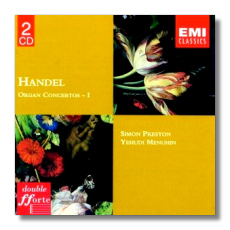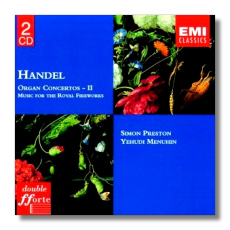
The Internet's Premier Classical Music Source
Related Links
- Handel Reviews
- Latest Reviews
- More Reviews
-
By Composer
-
Collections
DVD & Blu-ray
Books
Concert Reviews
Articles/Interviews
Software
Audio
Search Amazon
Recommended Links
Site News
 CD Review
CD Review
George Frideric Handel

Organ Concertos - I
- Organ Concertos #1-10
Simon Preston, organ
Menuhin Festival Orchestra/Yehudi Menuhin
EMI Classics 72676 ADD 2CDs: 62:38, 71:39


Organ Concertos - II
- Organ Concertos #11-15
- Concerto in B Flat for Double Woodwind, Orchestra & Organ
- Violin Concerto in B Flat
- Music for the Royal Fireworks
- Three Marches
Simon Preston, organ
Leslie Pearson, organ
Yehudi Menuhin, violin
Menuhin Festival Orchestra/Yehudi Menuhin
EMI Classics 72637 ADD 2CDs: 70:34, 51:37
Handel's likable organ concertos were written to be played between sections of his oratorios. As such, they probably functioned as classy background music for most of the attendees. The idea of listening to these concertos in attentive silence, either at home or in public, would be a strange one indeed to the audiences of Georgian England. Fortunately, we can choose exactly how we wish to interact with this music. Because, taken together, they are like a varied and exciting party, they work well as an invigorating complement to life's more mundane activities. However, like the people at a party, no two are alike. Furthermore – and here the analogy breaks down – not one of them is boring or pompous, so spending a little one-on-one time with each is well worth the effort too.
As I listen to this music, words such as "festive," "suave," and "imposing" all come to mind at different times. Perhaps the best place to start is with the lucky Concerto #13, also known as "The Cuckoo and the Nightingale." Its second movement contains the soloist's extended imitations of those two birds, solo and in duet. Handel's musical ornithology has made this euphoric concerto the most famous of the fifteen. The very first concerto, however, contains similar effects, and could have just as easily gone by the same name. Concerto #6 is familiar from its use in Alexander's Feast, and also in its version for harp, so it too could be the place to begin exploring. But wherever you start, don't postpone the pleasure of becoming acquainted with these full-bodied, happy works. They're surely among Handel's most attractive.
Menuhin and Preston recorded these concertos between 1967 and 1970. Four different venues were used: Merchant Taylors's Hall, Queen Elizabeth Hall, and St. Paul's Girls's School, all in London, and the Great Packington Church in Warwickshire. The latter location gives a notably bigger, more resonant sound that is appropriate for the more festive concertos. The recordings use modern instruments (except, perhaps, for the organs themselves), and there is little evidence of period performance practice. That's fine by me, and I think Handel would have appreciated the sound's richness, too. In other words, don't cheat yourself with an original instruments version: Menuhin and Preston give this music the royal treatment. These tuneful, rhythmically alert performances are difficult to better.
The second disc of the second set is comprised entirely of delightful bonuses; referring to it as "filler" would be too demeaning. The so-called "Double Concerto" contains material more familiar in Messiah as the chorus "For the glory of the Lord." Here, the organist is Leslie Pearson. (Self-borrowing was not unusual in Handel's time; for example the ad libitum movement of Organ Concerto #12 is based on a stately sarabande that Handel had used in his solo keyboard music.) The Violin Concerto, originally written for oboe, is a work of exalted serenity, and doing double duty as conductor and soloist, Menuhin makes it soar and sing. The Royal Fireworks Music is done with panache and a feeling for occasion.
These two sets are part of EMI's "Double FForte" series, which means you can get these four discs for the price of two. These would be my preferred versions at almost any price, however.
Copyright © 1999, Raymond Tuttle


















